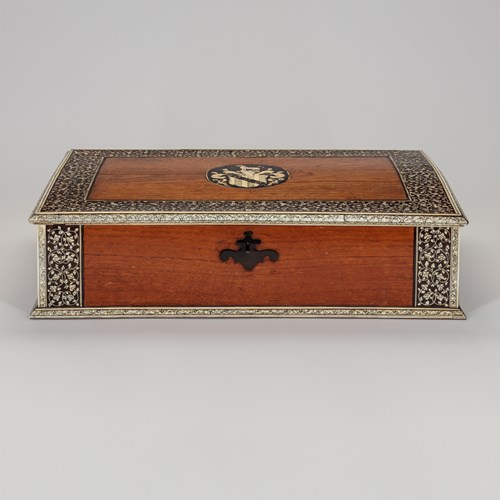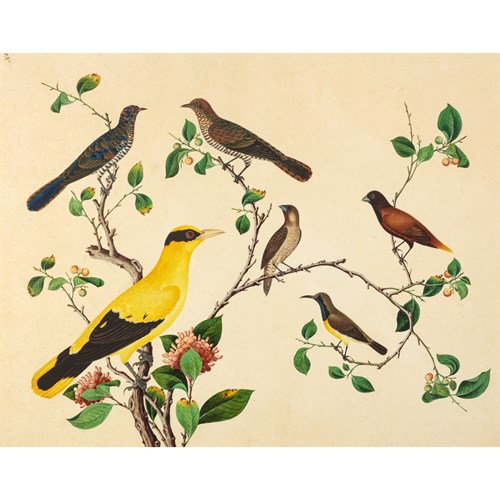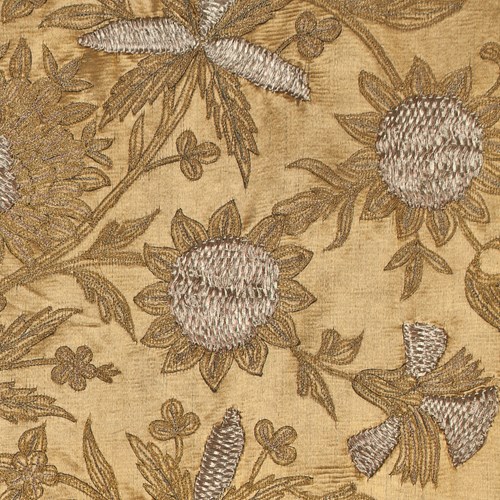Marketplace
Chinese pot and cover for the Thai market
Chinese pot and cover for the Thai market
Date Circa 1800
Period Early 19th century, Qing Dynasty
Origin China
Medium Porcelain decorated in underglaze cobalt blue
Dimension 26 x 20 cm (10¹/₄ x 7⁷/₈ inches)
Made for the Thai market, this Qing dynasty porcelain pot and cover is painted in underglaze cobalt blue and has a dense floral pattern. It carries several motifs and symbols that are part of Thai nature and culture. Almost hidden amongst leaves and flower motifs, four figures are repeated around the lid: it is the thep phanom motif, a person or rather a god, in the paryanka or “lotus” position, with hands joined in the gesture of prayer and adoration, the namaskara.
Among the botanical decorations, it is possible to recognise the most important of all: the lotus flower, a symbol of the purity of the Buddha. The lid itself adopts the form of a stupa or pagoda, a sacred building found all over the Buddhist world and it represents the universe as conceived by Buddhist thinking. It is in fact formed like a dome, with a superstructure having a lotus form finial that represents the progression of the Buddhist arhat or saint, on the way to purity, simplicity and nirvana.1
During the time of the Qing Dynasty (1644-1911), China traded extensively in porcelain. The wares were mainly produced in Jingdezhen, where potters perfected a variety of forms alien to Chinese taste but favoured by different foreign clients including the Thai royal court. When ceramics specifically destined for the Thai royal court were commissioned during the Qing period, the Jingdezhen decorators perfectly channelled Siamese styles and motifs to satisfy this new, aristocratic market.2
Footnotes:
1- Jens Braarvig, 2013. “Indian iconography on Bencharong”. In Royal Porcelain from Siam, edited by Anne Habu and Dawn F. Rooney. Oslo: Hermes Publishing. pp. 229-235.
2- Rose Kerr, 2013. “Bencharong and its place in the Qing Dynasty porcelain trade”. In Royal Porcelain from Siam, edited by Anne Habu and Dawn F. Rooney. Oslo: Hermes Publishing. p.69
外销泰国市场
中国,清朝,约1800年
高26厘米,直径20厘米
Stock no.: A5230
Among the botanical decorations, it is possible to recognise the most important of all: the lotus flower, a symbol of the purity of the Buddha. The lid itself adopts the form of a stupa or pagoda, a sacred building found all over the Buddhist world and it represents the universe as conceived by Buddhist thinking. It is in fact formed like a dome, with a superstructure having a lotus form finial that represents the progression of the Buddhist arhat or saint, on the way to purity, simplicity and nirvana.1
During the time of the Qing Dynasty (1644-1911), China traded extensively in porcelain. The wares were mainly produced in Jingdezhen, where potters perfected a variety of forms alien to Chinese taste but favoured by different foreign clients including the Thai royal court. When ceramics specifically destined for the Thai royal court were commissioned during the Qing period, the Jingdezhen decorators perfectly channelled Siamese styles and motifs to satisfy this new, aristocratic market.2
Footnotes:
1- Jens Braarvig, 2013. “Indian iconography on Bencharong”. In Royal Porcelain from Siam, edited by Anne Habu and Dawn F. Rooney. Oslo: Hermes Publishing. pp. 229-235.
2- Rose Kerr, 2013. “Bencharong and its place in the Qing Dynasty porcelain trade”. In Royal Porcelain from Siam, edited by Anne Habu and Dawn F. Rooney. Oslo: Hermes Publishing. p.69
外销泰国市场
中国,清朝,约1800年
高26厘米,直径20厘米
Stock no.: A5230
Date: Circa 1800
Period: Early 19th century, Qing Dynasty
Origin: China
Medium: Porcelain decorated in underglaze cobalt blue
Dimension: 26 x 20 cm (10¹/₄ x 7⁷/₈ inches)
More artworks from the Gallery









